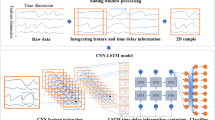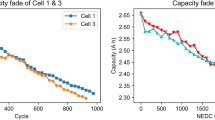Abstract
Industrial process data have the characteristics of heterogeneity, dimensional inconsistency and multi time scales, which increase the difficulty of condition evaluation in industrial process using multi-source data. To address these problems, a multi-source heterogeneous data fusion model is proposed for the condition evaluation of aluminum electrolysis cell. Firstly, the deep residual network (ResNet) is used to extract the superheat degree features of the fire hole video, the ResNet and wavelet packet are used to extract the cell voltage features, thereby achieving the isomorphism of heterogeneous data. An anode current features extraction method based on dynamic pivotal sequence is used to reduce the dimension of anode current data and extract features. Then, a fusion model of feature layer and data layer based on CatBoost is proposed, which comprehensively considers the material-energy balance mechanism knowledge and current efficiency to describe the dynamic coupling relationship between various data sources. The experimental evaluation results on the actual industrial aluminum electrolysis dataset show that our method improves the performance by 2.3% compared with existing multi-source data fusion method.















Similar content being viewed by others
Data availability
The data that support the findings of this study are available from aluminum electrolysis enterprises in Ningxia Hui Autonomous Region, but restrictions apply to the availability of these data, which were used under licence for the current study and so are not publicly available. The data are, however, available from the authors upon reasonable request and with the permission of aluminum electrolysis enterprises in Ningxia Hui Autonomous Region.
References
Yue W, Chen X, Gui W, Xie Y, Zhang H (2017) A knowledge reasoning Fuzzy-Bayesian network for root cause analysis of abnormal aluminum electrolysis cell condition. Front Chem Sci Eng 11(3):414–428
Zhan S, Li M, Zhou J, Yang J, Zhou Y (2014) CFD simulation of dissolution process of alumina in an aluminum reduction cell with two-particle phase population balance model. Appl Therm Eng 73(1):805–818
Majid NAA, Taylor MP, Chen JJJ, Stam MA, Mulder A, Young BR (2011) Aluminium process fault detection by multiway principal component analysis. Control Eng Pract 19(4):367–379
Yue W, Gui W, Chen X, Zeng Z, Xie Y (2019) A data and knowledge collaboration strategy for decision-making on the amount of aluminum fluoride addition based on augmented fuzzy cognitive maps. Engineering 5(6):1060–1076
Stam MA, Taylor M, Chen J, Mulder A, Rodrigo R (2008) Common behaviour and abnormalities in aluminium reduction cells. TMS Light Metals 2008:309–314
Yang C, Zhou L, Huang K, Ji H, Long C, Chen X, Xie Y (2019) Multimode process monitoring based on robust dictionary learning with application to aluminium electrolysis process. Neurocomputing 332:305–319
Deng Z, Chen X, Xie S, Xie Y, Sun Y (2021) Distributed process monitoring based on joint mutual information and projective dictionary pair learning. J Process Control 106:130–141
Deng Z, Chen X, Xie S, Xie Y, Zhang H (2022) Semi-supervised discriminative projective dictionary pair learning and its application for industrial process monitoring. IEEE Trans Industr Inf 19:3119–3132
Zeng Z, Gui W, Chen X, Xie Y, Wu R (2020) A mechanism knowledge-driven method for identifying the pseudo dissolution hysteresis coefficient in the industrial aluminium electrolysis process. Control Eng Pract 102:104533
Zeng Z, Gui W, Chen X, Xie Y, Zhang H, Sun Y (2021) A cell condition-sensitive frequency segmentation method based on the sub-band instantaneous energy spectrum of aluminum electrolysis cell voltage. Engineering 7(9):1282–1292
Li H, Jiang C (2011) Development and application of soft sensor model for heterogeneous information of aluminum reduction cells. Control Eng Pract 19(10):1109–1115
Xie S, Xie Y, Ying H, Jiang Z, Gui W (2020) Neurofuzzy-based plant-wide hierarchical coordinating optimization and control: an application to zinc hydrometallurgy plant. IEEE Trans Industr Electron 67(3):2207–2219
Wu D, Risk BJR (2016) Intelligence in big data era: a review and introduction to special issue. IEEE Trans Cybern 46(8):1718–1720
Zhao C, Yao Y, Gao F, Wang F (2010) Statistical analysis and online monitoring for multimode processes with between-mode transitions. Chem Eng Sci 65(22):5961–5975
Wang B, Li Z, Dai Z, Lawrence N, Yan X (2020) Data-driven mode identification and unsupervised fault detection for nonlinear multimode processes. IEEE Trans Ind Inf 16(6):3651–3661
Vogelbacher M, Matthes J, Keller HB, Waibel P (2019) Progression and evaluation of a camera-based measurement system for multifuel burners under industrial process conditions. IEEE Trans Ind Inf 15(10):5466–5474
Mori K, Nakajima H, Hata Y (2021) Automated worker skill evaluation for improving productivity based on labeled LDA. Int J Mach Learn Cybern 12(4):1151–1171
Ma H (2011) Formation drillability prediction based on multi-source information fusion. J Petrol Sci Eng 78(2):438–446
Han L, Lei Z (2012) Clustering methods for multi-sensor data fusion. In: International Conference on Industrial Control and Electronics Engineering
Zhang S, Feng T (2016) Optimal decision of multi-inconsistent information systems based on information fusion. Int J Mach Learn Cybern 7(4):563–572
Cai B, Liu Y, Fan Q, Zhang Y, Liu Z, Yu S, Ji R (2014) Multi-source information fusion based fault diagnosis of ground-source heat pump using Bayesian network. Appl Energy 114:1–9
Zhou Y, Zhou Q (2011) Research on multi-source data fusion model of safety monitoring for oil depot. In: International Conference on Electrical and Control Engineering
Zhou P, Gao B, Wang S, Chai T (2022) Identification of abnormal conditions for fused magnesium melting process based on deep learning and multisource information fusion. IEEE Trans Industr Electron 69(3):3017–3026
Ye T, Zhang Z, Zhang X, Chen Y, Zhou F (2021) Fault detection of railway freight cars mechanical components based on multi-feature fusion convolutional neural network. Int J Mach Learn Cybern 12(6):1789–1801
An J, Shen X, Wu M, She J (2019) A multi-time-scale fusion prediction model for the gas utilization rate in a blast furnace. Control Eng Pract 92:104120
Chen Z, Lu M, Zhou Y, Chen C (2021) Information synergy entropy based multi-feature information fusion for the operating condition identification in aluminium electrolysis. Inf Sci 548:275–294
Lei Y, Chen X, Xie Y, Cen L (2022) A self-supervised temporal temperature prediction method based on dilated contrastive learning. J Process Control 120:150–158
Sun Y, Gui W, Chen X, Xie Y, Xie S, Zou Z (2023) A dynamic spatial distributed information clustering method for aluminum electrolysis cell. Eng Appl Artif Intell 126:106793
Wan X, Cen L, Chen X, Xie Y (2022) A novel multiple temporal-spatial convolution network for anode current signals classification. Int J Mach Learn Cybern 13:3299–3310
He K, Zhang X, Ren S, Sun J (2016) Deep residual learning for image recognition. In: IEEE Conference on Computer Vision and Pattern Recognition (CVPR)
He K, Zhang X, Ren S, Sun J (2016) Identity mappings in deep residual networks. In: European Conference on Computer Vision (ECCV)
Daamouche A, Hamami L, Alajlan N, Melgani F (2012) A wavelet optimization approach for ECG signal classification. Biomed Signal Process Control 7(4):342–349
Cocchi M, Seeber R, Ulrici A (2001) WPTER: wavelet packet transform for efficient pattern recognition of signals. Chemom Intell Lab Syst 57(2):97–119
Banta L, Dai CX, Biedler P (2003) Noise classification in the aluminum reduction process. In: Light Metals Symposium held at the 132nd TMS Annual Meeting
Srivastava N, Hinton G, Krizhevsky A, Sutskever I, Salakhutdinov R (2014) Dropout: a simple way to prevent neural networks from overfitting. J Mach Learn Res 15:1929–1958
Kingma PD, Ba J (2015) Adam: a method for stochastic optimization. In: International Conference on Learning Representations (ICLR)
Hills J, Lines J, Baranauskas E, Mapp J, Bagnall A (2014) Classification of time series by shapelet transformation. Data Min Knowl Disc 28(4):851–881
Lines J, Davis LM, Hills J, Bagnall A (2012) A shapelet transform for time series classification. In: ACM SIGKDD Conference on Knowledge Discovery and Data Mining (SIGKDD)
Friedman JH (2001) Greedy function approximation: a gradient boosting machine. Ann Stat 29(5):1189–1232
Zhou Q, Mao G, Li Y (2022) A fusion CNN driven by images and vibration signals for fault diagnosis of gearbox. J Phys: Conf Ser 2252(1):012076
Zhang Y, Feng K, Ma H, Yu K, Ren Z, Liu Z (2022) MMFNet: Multisensor data and multiscale feature fusion model for intelligent cross-domain machinery fault diagnosis. IEEE Trans Instrum Meas 71:1–11
Mao G, Zhang Z, Qiao B, Li Y (2022) Fusion domain-adaptation CNN driven by images and vibration signals for fault diagnosis of gearbox cross-working conditions. Entropy (Basel) 24(1):119
Karabacak Y, Gürsel Ozmen N, Gümüs L (2022) Intelligent worm gearbox fault diagnosis under various working conditions using vibration, sound and thermal features. Appl Acoust 186:108463
Li Y, Du X, Wang X, Si S (2022) Industrial gearbox fault diagnosis based on multi-scale convolutional neural networks and thermal imaging. ISA Trans 129(Pt B):309–320
Sun D, Li Y, Jia S, Feng K, Liu Z (2023) Non-contact diagnosis for gearbox based on the fusion of multi-sensor heterogeneous data. Inf Fusion 94:112–125
Wang X, Mao D, Li X (2020) Bearing fault diagnosis based on vibro-acoustic data fusion and 1D-CNN network. Measurement 173:108518
Iandola FN, Han S, Moskewicz MW, Ashraf K, Dally WJ, Keutzer K (2016) Squeezenet: AlexNet-level accuracy with 50x fewer parameters and <0.5MB model size. In: International Conference on Learning Representations (ICLR)
Zhang X, Zhou X, Lin M, Sun J, Recognition P (2017) ShuffleNet: An extremely efficient convolutional neural network for mobile devices. In: IEEE Conference on Computer Vision and Pattern Recognition (CVPR)
Howard AG, Zhu M, Chen B, Kalenichenko D, Wang W, Wey T, Andreetto M, Adam HJA (2017) MobileNets: efficient convolutional neural networks for mobile vision applications. In: IEEE Conference on Computer Vision and Pattern Recognition (CVPR)
Huang G, Liu Z, Weinberger KQ, Recognition P (2017) Densely connected convolutional networks. In: IEEE Conference on Computer Vision and Pattern Recognition (CVPR)
Chollet F, Recognition P (2017) Xception: Deep learning with depthwise separable convolutions. In: IEEE Conference on Computer Vision and Pattern Recognition (CVPR)
Szegedy C, Liu W, Jia Y, Sermanet P, Reed S E, Anguelov D, Erhan D, Vanhoucke V, Rabinovich A, Recognition P (2014) Going deeper with convolutions. In: IEEE Conference on Computer Vision and Pattern Recognition (CVPR)
Szegedy C, Vanhoucke V, Ioffe S, Shlens J, Wojna Z, Recognition P (2016) Rethinking the inception architecture for computer vision. In: IEEE Conference on Computer Vision and Pattern Recognition (CVPR)
Szegedy C, Ioffe S, Vanhoucke V, Alemi AA (2017) Inception-v4, Inception-ResNet and the impact of residual connections on learning. In: AAAI Conference on Artificial Intelligence (AAAI)
Simonyan K, Zisserman A (2014) Very deep convolutional networks for large-scale image recognition. In: International Conference on Learning Representations (ICLR)
Bruna J, Zaremba W, Szlam AD, Lecun Y (2014) Spectral networks and locally connected networks on graphs. In: International Conference on Learning Representations (ICLR)
Defferrard M, Bresson X, Vandergheynst P (2016) Convolutional neural networks on graphs with fast localized spectral filtering. In: Conference on Neural Information Processing Systems (NeurIPS)
Kipf T, Welling MJA (2017) Semi-supervised classification with graph convolutional networks. In: International Conference on Learning Representations (ICLR)
Acknowledgements
This work was supported in part by the National Natural Science Foundation of China (Grant Nos. 62133016), the Basic Science Research Center Program of National Natural Science Foundation of China (Grant No.61988101), the National Science Foundation for Distinguished Young Scholars of China (Grant No. 61725306).
Funding
National Natural Science Foundation of China, 62133016, Xiaofang Chen, 61988101, Weihua Gui, National Science Foundation for Distinguished Young Scholars of China, 61725306, Yongfang Xie.
Author information
Authors and Affiliations
Corresponding author
Ethics declarations
Conflict of interest
The authors declare that they have no known competing financial interests or personal relationships that could have appeared to influence the work reported in this paper.
Additional information
Publisher's Note
Springer Nature remains neutral with regard to jurisdictional claims in published maps and institutional affiliations.
Rights and permissions
Springer Nature or its licensor (e.g. a society or other partner) holds exclusive rights to this article under a publishing agreement with the author(s) or other rightsholder(s); author self-archiving of the accepted manuscript version of this article is solely governed by the terms of such publishing agreement and applicable law.
About this article
Cite this article
Sun, Y., Gui, W., Chen, X. et al. Evaluation model of aluminum electrolysis cell condition based on multi-source heterogeneous data fusion. Int. J. Mach. Learn. & Cyber. 15, 1375–1396 (2024). https://doi.org/10.1007/s13042-023-01973-9
Received:
Accepted:
Published:
Issue Date:
DOI: https://doi.org/10.1007/s13042-023-01973-9




